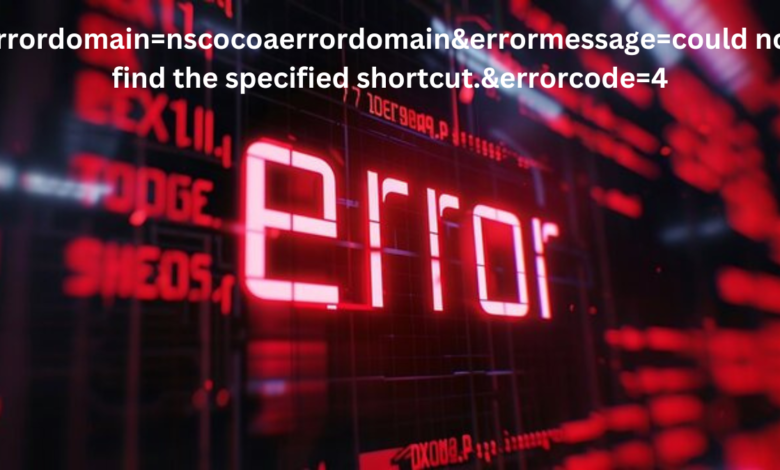Understanding the Error: “errordomain=nscocoaerrordomain&errormessage=could not find the specified shortcut.&errorcode=4”

errordomain=nscocoaerrordomain&errormessage=could not find the specified shortcut.&errorcode=4 – Errors can be frustrating, especially when they appear unexpectedly and without much explanation. One such error that has been causing confusion for some users is: “errordomain=nscocoaerrordomain&errormessage=could not find the specified shortcut.&errorcode=4.” If you’ve come across this error while using your Mac or iOS device, don’t worry—you’re not alone. In this article, we’ll explore what this error means, why it occurs, and how you can resolve it with ease.
What Is NSCocoaErrorDomain?
When it comes to the nscocoaerrordomain, the essential components of an error will have to be examined instead closely. The first part of the error-errordomain=nscocoaerrordomain- indicates the origin of the error. One of the Guidelines describes using NSCocoaErrorDomain within Apple’s Cocoa framework. This framework is essential for developing desktop and mobile applications on the macOS and iOS operating systems. Hence, an error is said to occur when some Cocoa operations, which could be file operations, data operations, or operations on the user interface, go wrong.
Why Is It Important?
This is primarily why the Cognos and Ad Hoc development toolbox is built on the cocoa framework. It is common sense that members of this domain are paramount to virtual machines and general application paradigms. Macos has promoted the creation and use of golden triangles for decentralized computing by employing tussles in tacit complementarity. Hence, Software errors that fall under the domain of cocoa errors, commonly called NSCocoaErrorDomain, are often due to improper handling of some devices on some applications or system features.
Common NSCocoaErrorDomain Errors
However, the error we are discussing here concerns the shortcuts; the nsapplecocoaerrordomain can be related to other issues, such as problems with file access rights, file loss, or data formatting. Having this knowledge helps eliminate nearly half of the possibilities while working on this particular problem.
Deconstructing the Reported Error
The second aspect of the error, looking for the specified shortcut, errormessage=could not find, gives us some intelligible facts regarding the cause of the malfunction. This message lets us know that there is a shortcut that is no longer available, but your device tries to use it.
What Are the Shortcuts Available on Mac OS And Mac or IOS?
Shortcuts are basically commands or scripts that assist you in completing various actions on your Mac or iPhone more efficiently. Whether you’re launching an app, sending a message, or performing a more complex sequence of tasks, shortcuts can optimize these actions. The user may create some shortcuts, while others may be available by default.
What is the Reason for the Error?
The error occurs due to an attempt to perform a shortcut that is either not viable or needs to be visible on your device. There are a few reasons this could happen:
- The shortcut might have been deleted accidentally.
- A recent system update could have changed or removed it.
- The shortcut could be located in a path that is no longer valid.
Understanding ErrorCode=4
The final part of the error, errorcode=4, is a numeric code that corresponds to a specific problem within the NSCocoaErrorDomain. Error codes are a way for the system to categorize and describe different types of errors. In this case, errorcode=4 is linked to a file or resource not being found.
What Does ErrorCode=4 Mean?
Simply put, errorcode=4 means that the system was unable to locate the requested shortcut file or resource. In Apple’s framework, this particular error code is a general “file not found” error. While it might seem alarming, the solution is often straightforward once you identify which file or shortcut is missing.
Possible Causes of ErrorCode=4
- Corrupted shortcuts: A shortcut might be corrupted or not functioning as expected, leading to this error.
- App permissions: Certain apps may not have the required permissions to access the shortcut, which triggers the error.
- File path changes: If the file path to the shortcut has changed, the system may no longer be able to locate it.

How to Fix the Error
Now that we’ve dissected the error message and its components, let’s look at how to resolve it. Depending on the root cause, you can try several methods to fix the problem.
Method 1: Recreate the Shortcut
The easiest way to resolve this error is to recreate the missing shortcut. If you know which shortcut caused the error, simply create it again using the Shortcuts app on macOS or iOS. This should re-establish the correct path for the system to follow.
- Steps to recreate a shortcut:
- Open the Shortcuts app.
- Tap the + icon to create a new shortcut.
- Set up the desired actions and save it.
- Test the shortcut to ensure it’s working properly.
Method 2: Restore from Backup
If the shortcut previously worked and was deleted accidentally, you may be able to restore it from a backup. If you use iCloud to back up your devices, it’s easy to retrieve old shortcuts.
- Steps to restore a shortcut from iCloud:
- Go to Settings > iCloud > iCloud Backup.
- Look for the backup that contains your old shortcut.
- Restore the backup or manually find the shortcut file.
Method 3: Check for Software Updates
Sometimes, this error can be triggered by outdated software. If your device is running an older version of macOS or iOS, it might not handle certain shortcuts properly. Always ensure that your system is up-to-date to avoid compatibility issues.
- Steps to update your software:
- Go to Settings > General > Software Update.
- Install any available updates.
- Restart your device and see if the error persists.
Method 4: Verify App Permissions
Some shortcuts may involve third-party apps, and these apps need proper permissions to function correctly. If an app doesn’t have permission to execute a shortcut, you might see this error.
- Steps to verify app permissions:
- Go to Settings > Privacy.
- Check the permissions for the apps involved in your shortcut.
- Ensure that the necessary permissions (e.g., file access, location) are enabled.
Eliminating Future Shortcomings
People generally dislike erroneous mistakes, especially when they are unexpected and occur during work. Fortunately, there are some preventative approaches that can be taken to lessen or even eradicate the chances of this type of error happening in the future.
Backup That Data
Backing up your shortcuts and other important files as often as possible should become part of your user routine. To ensure you do not lose your shortcuts for any reason, please use iCloud or other relevant services.
Software for Your Operations
Remember to refresh the operating system and the applications you are working with. As we have discussed, Apple releases more patches and fixes related to issues; hence, staying alone with the issues will be dangerous since the chances of getting rid of them will be slim.
Changes to the Shortcut
You should exercise caution when deleting or editing shortcuts. You should also note shared shortcuts and ensure that they are made or updated on all devices to prevent them from being out of sync if they are shared among several devices.
Conclusion
The errordomain=nscocoaerrordomain&errormessage=could does not find the specified shortcut.&errorcode=4 error might appear pretty complicated, but understanding and fixing the issue will become easy once it is broken down. You now have a way to do this for recreating a shortcut, restoring from a backup, or simply updating your software. Therefore, following the troubleshooting steps and the preventative measures discussed in this article helps.
You may also read.
errordomain=nscocoaerrordomain&errormessage=could not find the specified shortcut.&errorcode=4



